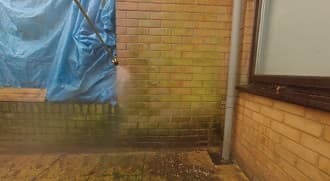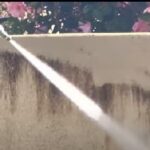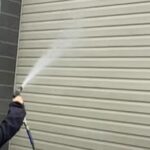As an Amazon Associate, this site earns commissions from qualifying purchases. For more information click here.
Algae, mold and mildew can accumulate on wood, concrete and other surfaces. Over time, algae makes the surface of concrete susceptible to moisture and cause damage. A pressure washer is an effective way to remove algae from different types of surfaces. For this to work though, you have to use the pressure washer correctly.
A pressure washer can remove algae on concrete, wood and other surfaces. You may add detergents to the water but make sure it will not damage the surface. Use a 15 degree nozzle to wash algae off concrete and 25 degree nozzle for wood.
Will a Pressure Washer Remove Algae from Concrete?
A pressure washer is more than capable of getting rid of algae. It is more powerful than a garden hose and is the ideal solution for algae stuck on concrete.
In the following sections we will show you how to pressure wash algae off concrete. But first we have to emphasize that it takes more than just power washing. You have to use chemicals, cleaning solutions or detergents too.
The type of cleaning solutions to use will depend on the material you are cleaning. For concrete, you may use concrete cleaning solutions or mix liquid bleach with water. Usually the mixture is one quarter cup of bleach per gallon of water. If you are removing algae from a wood deck, use a cup of vinegar per gallon of water.
Do not use cleaning solutions with acid as it will destroy the surface, whether it is concrete or wood. Bleach works well with concrete as well as baking soda. If you have a deck made from composite wood, it might require a special cleaning solution. Contact the vendor for details.
Before proceeding, follow all safety guidelines for using pressure washers.
How to Pressure Wash Algae from Concrete Step by Step
Now you can start removing algae. Before proceeding, make sure to have all the tools and materials. This method also works for removing mildew and mold. If you are getting rid of alga on a wood deck, replace the bleach with detergents that are safe for wood.
What You Will Need
- Pressure washer (the Wholesun WS3000 electric pressure washer is a good choice)
- Algae cleaning solution for pressure washer
- Hot water
- Nozzle (the Twinkle Star kit has all the nozzles you will need)
- Bleach
- Hard bristle brush
- Boots
- Gloves
- Eyewear protection
Step 1: Preparation
Wear boots, gloves and safety goggles. Yellow nozzles – which you will use – produce more force than the typical green nozzles used at home, so be careful.
Inspect the pressure washer before using it. Check if it is working. Go over the area you will spray and remove any plants or garden furnishing that might get doused with water. Pressure washers produce more power than a garden hose so make sure the area is clear.
Step 2: Preliminary cleaning
Pour a gallon of hot or warm water in a container. Add a quarter cup of bleach. Dip a hard bristle brush into the mix. Be careful not to hurt yourself. Remember to put on gloves before you start. You do not want bleach to make contract with your skin.
Scrub the part of the concrete with algae well. Repeat this process for every area of the concrete with algae.
If you are power washing a wood deck, use a cup of vinegar mixed with a gallon of water. Scrub the surface the same way you would concrete.
Step 3: Mix the pressure wash detergent
Buy an algae cleaning solution that is compatible with your pressure washer. Make certain the product is compatible, otherwise it can damage the pressure washer. The detergent must also be safe for use on concrete.
Prepare the algae detergent according to the package instructions. Pour the mixture into the pressure washer reservoir.
Choose a nozzle for pressure washing concrete. For the first wash you will use a low pressure detergent nozzle. For the second wash, a 15 degree yellow nozzle. If you are going to pressure wash wood decks, use only gentle nozzles.
Step 4: Pressure wash the surface
Turn the pressure washer on. Spray the concrete in sections from top to bottom. As mentioned in the previous step, you will use a detergent nozzle for the first wash. A low pressure wash is ideal as you want to do a general cleaning. Position the detergent nozzle about six inches from the surface. Adjust the distance accordingly.
Once you are done, give the detergent time to get absorbed into the concrete. Give it a few minutes or whatever is stated in the algae cleaning package.
Step 5: Pressure wash again
Once the surface has soaked in the cleaning solution, you can proceed with a high pressure cleaning. Now that the detergent has worked its way into the concrete, the algae and mold will be washed away along with the water.
Switch to a 15 degree yellow nozzle. Pour warm water into the pressure washer tank. Position the nozzle 6-10 inches from the concrete surface. Spray in sections and wash the detergent away as thoroughly as you can.
After pressure washing, go over the concrete. You might have to do another pass if there is algae or mildew left. If there is, another round of high pressure washing should do it.
Step 6: Apply concrete sealant
If the concrete is free of algae, turn off the pressure washer. Let the surface dry before you apply concrete sealant.
By applying a concrete sealant, you minimize the possibility of mold, algae etc. from appearing again. There are a lot of options available, but use only a product that is safe for concrete. Oxygen bleach is one and there are others.
Apply the concrete sealant according to the product instructions. Usually you only need to apply two coats. The first coat penetrates the surface and safeguards the concrete. The second coating will give the surface a shiny, clean look.
The second coating is optional and you can do without it. Do not use three coatings as it can damage the concrete and make the surface susceptible to moisture.

Frequently Asked Questions
How often should I pressure wash concrete to prevent algae?
Once a year is enough. After washing, remember to apply concrete sealant to prevent algae from returning. Avoid pressure washing too often because it can ruin the surface. When you have removed algae, you can maintain concrete clean by garden hosing and sweeping debris with a broom.
Why does algae grow on concrete?
Algae prefers hard surfaces, especially if it is shaded and moist. Under these conditions, algae will spread through the surface. It can happen not just on driveways but any concrete surface.
Does algae damage concrete?
Algae can permanently discolor concrete if not removed right away. It does not cause any more damage, but it is unsightly. The biggest problem with algae is it makes concrete slippery. This can be a hazard to anyone who walks over it.
Should I use hot or cold water when pressure washing algae?
Use hot water because it is prove n to work. In fact if there is only a small amount of algae, pouring hot water can get rid of it.
Is it true that bleach can damage concrete and ruin its color?
Only if you use too much. A quarter cup of bleach per gallon of water will not cause harm. It will however, be potent enough to remove algae.
What is the best way to prevent algae from building up in concrete?
Do not let the concrete surface turn moist. Dry it as soon as possible. When algae, mildew or mold does appear, get rid of it as soon as possible. This is where your pressure washer comes into play.
Can I use a red nozzle on concrete?
No, red nozzle tips are too powerful and will damage the surface. Use either green or yellow nozzles. For light cleanup, the 25 degree green nozzle is enough. For caked dirt and lots of algae, use yellow.

I love the outdoors and all the tools for maintaining gardens, yards and lawns. The only thing I am more passionate about is sharing what I know about garden and outdoor equipment.


